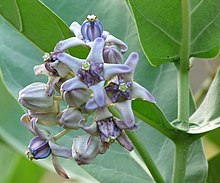Calotropis gigantea
| Calotropis gigantea | |
|---|---|
 |
|
| Scientific classification | |
| Kingdom: | Plantae |
| (unranked): | Angiosperms |
| (unranked): | Eudicots |
| (unranked): | Asterids |
| Order: | Gentianales |
| Family: | Apocynaceae |
| Subfamily: | Asclepiadoideae |
| Genus: | Calotropis |
| Species: | C. gigantea |
| Binomial name | |
|
Calotropis gigantea (L.) W.T.Aiton 1811 not (L.) R. Br. 1811 |
|
| Synonyms | |
|
|
Calotropis gigantea (crown flower) is a species of Calotropis native to Cambodia, Indonesia, Malaysia, the Philippines,Thailand, Sri Lanka, India, China, Pakistan, Nepal, and tropical Africa.
It is a large shrub growing to 4 m (13 ft) tall. It has clusters of waxy flowers that are either white or lavender in colour. Each flower consists of five pointed petals and a small "crown" rising from the center which holds the stamens. The aestivation found in calotropis is valvate i.e. sepals or petals in a whorl just touch one another at the margin, without overlapping. The plant has oval, light green leaves and milky stem. The latex of Calotropis gigantea contains cardiac glycosides, fatty acids, and calcium oxalate.
This plant plays host to a variety of insects and butterflies. It is the host plant for Hawaii's non-migratory monarch butterflies.Calotropis is an example of entomophily pollination (pollination by insects) and pollination is achieved with the help of bees. In Calotropis, gynostegium is present (formed by the fusion of stigma and androecium). The pollen are in a structure named pollinia which is attached to a glandular, adhesive disc at the stigmatic angle (translator mechanism). These sticky discs get attached to the legs of visiting bees that pull out pollinia when a bee moves away. When such a bee visits another flower, this flower might be pollinated by the pollinium.
...
Wikipedia
